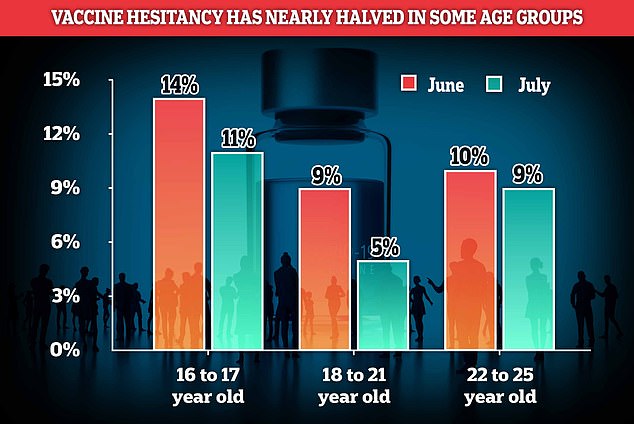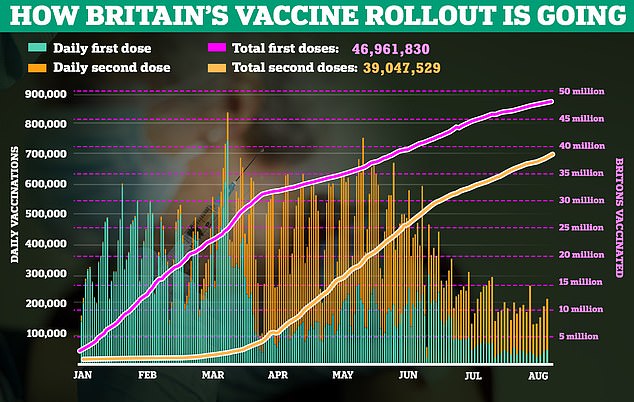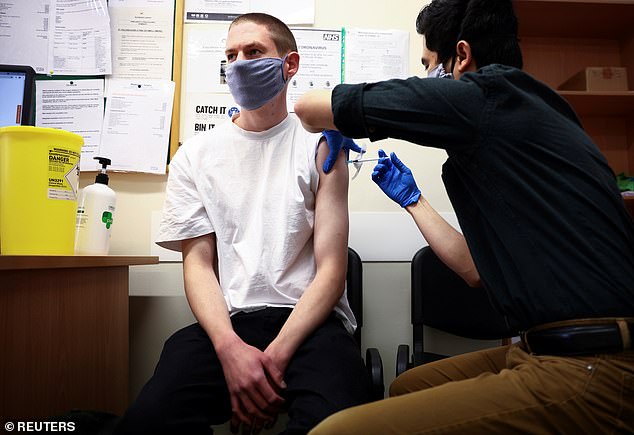Covid vaccine hesitancy rates have nearly halved among younger people, official figures suggested today.
Just one in 20 Brits aged 18 to 21 claimed they were unlikely to get a jab last month, according to data released by the Office for National Statistics.
This compares to nearly one in 10 (nine per cent) who admitted they were hesitant when asked one month earlier.
And overall, there were drop in hesitancy among all under-25s in July compared to levels in June.
The findings, based on polling of 15,000 adults, are from before ministers unveiled plans to lure twenty-somethings into vaccine centres with the promise of cut-price taxis and takeaways.
It suggests the rate may be even lower now, given the incentives were designed to drive take-up among 18 to 30 year olds.
Separate ONS statistics showed hesitancy rates were five times higher among black adults, compared to white people.
And the figures also revealed 89 per cent of 16 and 17 year olds — who are now able to get vaccinated — want a jab.

The biggest drop in Covid vaccine hesitancy between June and July was seen in 18 to 21-year-olds, with nearly half as many people saying they were still reluctant to get the jab. Meanwhile, four per cent less people aged 16 and 17 were concerned about the jabs by July 18 and one per cent less 22 to 25-year-olds reported hesitancy

Kebabs for jabs: Uber and Deliveroo will offer young adults cheap food in exchange for a Covid vaccine
Young adults will be lured into vaccination centres with the promise of cut-price taxis and takeaways, as Boris Johnson tries to tackle the relatively low take-up among the under-30s.
Uber, Deliveroo and Pizza Pilgrims are among the companies in discussion with the Government about offering incentives as part of the ‘Jab 18-30’ drive.
So far, only two-thirds of people in that age bracket in England have received a first dose since they became eligible in June, compared with 88.4 per cent across all age groups, meaning more than three million 18-to-30-year-olds remain unjabbed.
As part of the plan, Uber will be sending out reminders to its users throughout this month and, along with rival ride-hailing app Bolt, will be offering discounts for under-30s in both cars and food takeaway services.
Other companies will be offering vouchers or discount codes for food and films if users can prove through the NHS app that they have had the jab.
Advertisement
The ONS asked 15,433 over-16s England, Scotland and Wales about their attitudes towards the vaccines between June 23 to July 18 – a day before ‘Freedom Day’ in England.
It meant the drop occurred before the Government announced on July 19 that only double-jabbed people in England can go to go to nightclubs and venues with large crowds from the end of next month.
More than 47million first jabs have been dished out across the UK — equating to 88.9 per cent of over-18s.
And 39.4million people — close to three-quarters of the country’s adult population — are now fully immunised.
The roll-out has now been opened to 16 and 17 year olds.
The ONS found hesitancy rates dropped slightly among the oldest teens, from 14 per cent in June to 11 per cent in July.
Overall, more than nine in 10 adults (96 per cent) had positive sentiment towards the injections.
The number was unchanged from the previous finding, which covered May 26 to June 20.
For the survey, vaccine hesitancy refers to adults who have chosen not to be vaccinated, report being very or fairly unlikely to have a vaccine if offered or responded ‘neither likely nor unlikely’, ‘don’t know’ or ‘prefer not to say’ when asked how likely they would be to get a jab if offered.
Since it began surveying Brits last December, hesitancy has dropped from 16 per cent.But the most recent data shows there has been a slight increase in hesitancy in 26 to 29-year-olds, where 9 per cent now say they do not want the jab, compared to 7 per cent last month.
Numbers also increased slightly among people in their 50s and 60s, rising by one per cent.
Meanwhile, hesitancy was lowest in the under-70s, with less than one per cent wary of getting vaccinated.
Officials have expressed concern about low uptake in younger groups, with less than two thirds of under-35s coming forward for a vaccine, despite the jabs being offered a jab in June.
This prompted initiatives including discounts for taxis and takeaways for young people who get a vaccine, as well as some nightclubs hosting pop-up vaccination sites.
And Sussex University said it will put vaccinated students in a prize draw to win up to £5,000.

Vaccine hesitancy rates in Brits aged between 18 and 21 have fallen from nine to five per cent in a month, according to figures from the ONS. (Pictured: a person receives a dose of the Pfizer/BioNTech jab at a vaccination centre for young people and students at the Hunter Street Health Centre in London on June 5)
The ONS found attitudes towards the jabs varied across Britain, with just three per cent of people in Scotland reporting hesitancy.
Higher levels were reported in England (four per cent) and Wales (five per cent).
Among all groups, the West Midlands was the region with the highest hesitancy rates (nine per cent).
But this rose among unemployed people in living in the area, where one in four (24 per cent) did not want a jab.
That group is closely followed by under-30s in the West Midlands, where one in five are not keen for a Covid vaccine.
Separate figures from the ONS show black adults are five times more reluctant (21 per cent) compared to white adults (four per cent).
Hesitancy was also higher than the national average among ethnic minority groups (nine per cent), mixed race adults (seven per cent) and Asian adults (six per cent).
People identifying as Muslim are three times more likely to be reluctant to get the vaccine (14 per cent) compared to Christians (four per cent).
Jewish people surveyed (six per cent) also reported higher hesitancy.
Adults living in deprived areas are four times less likely to get the jab than those living in the wealthiest areas.
Some eight per cent of those living in the most deprived areas were not keen to get a jab.
Hesitancy dropped as deprivation dropped, with 98 per cent opting to get the jab in the most wealthy groups.
Source link : https://www.dailymail.co.uk/news/article-9876151/Covid-vaccine-hesitancy-rates-HALVED-18-21-year-olds-95-willing-jabbed.html











